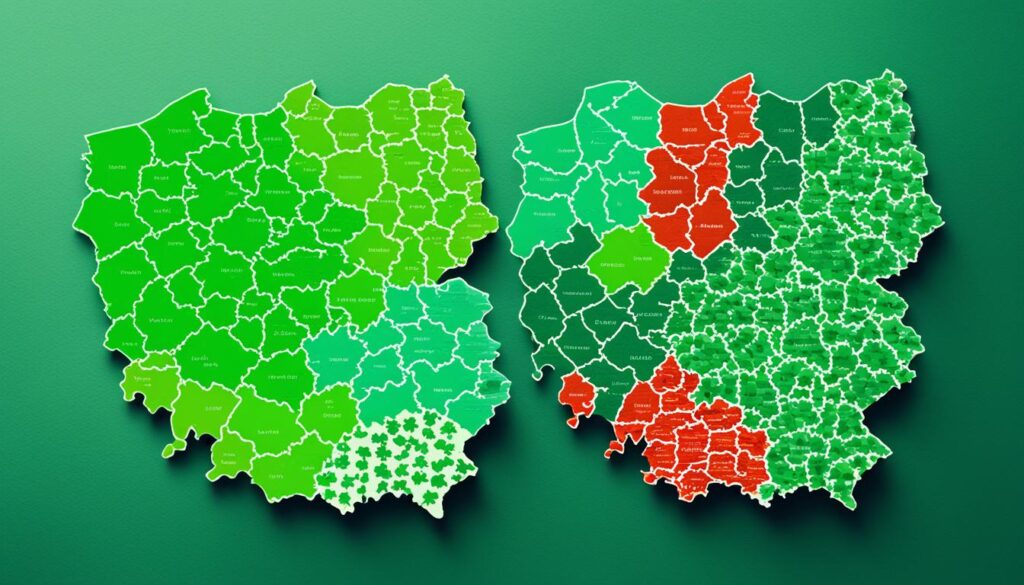As Poland’s economy continues to grow, so do the wages. The average salary in Poland stands at around PLN 7,590 per month, which is approximately USD 1,913 as of November 2023. This figure reflects the country’s economic strides and the rising income levels in Poland. However, several factors such as location, industry, experience, and education level influence these numbers significantly.
Urban areas like Warsaw, Krakow, and Wroclaw typically offer higher wages due to the concentration of high-paying sectors. For instance, the average salaries in these cities are PLN 8,510, PLN 8,290, and PLN 8,060 per month respectively. Despite these elevated wages, the cost of living in Poland remains relatively low, bolstering the purchasing power of the workforce compensation in Poland. Nevertheless, there remains a notable gap between the Polish average income and the minimum wage, which was last recorded at PLN 4,242 gross per month.
Additionally, a common benefit for Polish workers is the 13th-month bonus pay, which can further impact the total annual earnings. Given the 8% average salary increase every 17 months, Poland remains competitive in the European job market. This article aims to provide comprehensive Poland salary insights, detailing not only the overall averages but also the many factors that affect income levels in Poland.
Key Takeaways
- The average salary in Poland is PLN 7,590 per month, or approximately USD 1,913.
- There are significant salary disparities based on location, with Warsaw offering the highest at PLN 8,510 per month.
- The minimum wage in Poland is PLN 4,242 gross per month as of July 2023.
- Polish workers often receive a 13th-month bonus, affecting overall annual earnings.
- On average, employees with a certificate or diploma earn 17% more than high school graduates.
Overview of Average Wages in Poland
The landscape of wages in Poland continues to evolve, reflecting the dynamics of the nation’s economic growth. As of 2024, the average monthly salary in Poland stands at approximately PLN 7,590, indicating a positive trend in Poland wage trends. Regional disparities, economic factors wages Poland, and various industry demands play crucial roles in shaping these figures.
Current Average Salary Statistics
Analyzing the current Poland remuneration data, we observe significant differences across various regions. In the Warsaw Metropolitan Area, average salaries typically range from PLN 6,000 to PLN 8,000 per month. Meanwhile, southern Poland offers competitive wages ranging from PLN 5,000 to PLN 7,000 per month, and northern Poland ranges from PLN 4,500 to PLN 6,500 monthly. Contrastingly, eastern Poland sees lower averages, ranging from PLN 4,000 to PLN 5,500 per month, while rural areas offer the lowest, hovering around PLN 3,000 to PLN 4,500.
Factors Influencing Average Wages
Several economic factors wages Poland significantly influence average wages, including sector-specific trends and regional economic activities. For instance, IT professionals in Poland can command salaries between PLN 6,000 and PLN 10,000 per month. The finance and banking sectors boast even higher wages, often exceeding PLN 10,000 per month. In contrast, sectors like healthcare and education see professionals earning between PLN 3,000 and PLN 6,000 per month. Negotiations and the size of the employing company also play pivotal roles in determining salaries.
Comparison with Other European Countries
Despite demonstrating growth, Poland’s average wage remains lower in a European salary comparison. For instance, in Switzerland, the average annual salary is around €84,159, vastly surpassing Poland’s €20,390. Neighboring Czechia presents a similar competitive stance but still falls short with an annual average salary of €19,200. However, Poland’s lower cost of living provides a balanced perspective in this comparison, offering an economic advantage despite the lower wage figures.
| Region | Average Monthly Salary (PLN) |
|---|---|
| Warsaw Metropolitan Area | 6,000 – 8,000 |
| Southern Poland | 5,000 – 7,000 |
| Northern Poland | 4,500 – 6,500 |
| Eastern Poland | 4,000 – 5,500 |
| Rural Areas | 3,000 – 4,500 |
| Profession | Average Monthly Salary (PLN) |
| IT Professionals | 6,000 – 10,000 |
| Finance & Banking | 10,000+ |
| Healthcare | 3,000 – 6,000 |
| Education | 3,000 – 6,000 |
Factors Influencing Salaries

Several key factors play a crucial role in determining salaries in Poland, leading to notable variations in pay depending on the region, industry, and individual qualifications and experience. These salary determinants result from intricate interactions between economic conditions, education systems, and labor market dynamics.
Regional Variations
One of the prominent salary determinants in Poland is regional income differences. Metropolitan areas such as Warsaw and Kraków present higher average monthly salaries compared to rural areas. For instance, the average salary is PLN 8,510 in Warsaw and PLN 8,290 in Kraków, contrasting with the national average of PLN 7,768. These income disparities are often driven by the concentration of businesses, foreign investments, and higher living costs in urban centers.
Impact of Industry Sector
The sectoral wage impact is another significant factor influencing salary levels. Certain industries like IT, healthcare, and finance offer higher average salaries due to the demand for specialized skills and the economic value these sectors generate. For example, the average salary in the pharmaceutical industry is PLN 10,200, which is 34% higher than the national average. Similarly, the banking sector boasts an average monthly salary of PLN 8,220, reflecting the sectoral wage impact. These sectors also demonstrate different salary increment rates, with healthcare experiencing an 8% annual increment and IT seeing a 6% increase.
Role of Education and Experience
The Polish education return on investment is apparent in salary statistics. Higher educational qualifications lead to better compensation, with master’s degree holders earning 29% more than those with a bachelor’s degree. Additionally, work experience contributes significantly to wage growth. Employees with 2-5 years of experience earn approximately 32% more than their junior counterparts. This incremental growth continues, with those having over 15 years of experience earning 14% more than those with less tenure.
In conclusion, understanding the various salary determinants Poland faces, such as regional income differences, sectoral wage impact, and the return on investment in education, is essential. For further insights into how average salaries vary across occupations, industry sectors, and regions in Poland, visit the comprehensive analysis at Poland Inc Prime.
| Industry | Average Monthly Salary (PLN) | Annual Increment Rate |
|---|---|---|
| IT | 8,200 | 6% |
| Healthcare | 9,500 | 8% |
| Pharmaceutical | 10,200 | 9% |
| Finance & Accounting | 7,790 | 10% |
Minimum Wage in Poland

The minimum wage standards in Poland have seen significant changes over the years, reflecting shifts in the economic landscape and government policy. As of January 2025, the gross monthly minimum wage increased to PLN 4,242, with another scheduled increase to PLN 4,300 in July 2025, marking a substantial rise from PLN 3,600 in the previous year. These adjustments are part of the Polish government’s plan to enhance minimum wage standards by over 23% between now and mid-2025.
Despite this increase, the minimum wage is still considerably lower than the average gross salary in Poland, which was PLN 6,346 in 2022 and rose to PLN 6,884 in January 2023. As of January 2025, the average wage rose by 12.8% year-on-year to PLN 7,768 before taxes, emphasizing the existing discrepancies in monthly earnings in Poland across different sectors.
Current Minimum Wage Rates
The current minimum wage in Poland stands at PLN 4,242 gross monthly as of January 2025, with a planned increment to PLN 4,300 by July 2025. This reflects a notable increase from previous years: in 2021, the minimum wage was PLN 2,800, and in 2022 it rose to PLN 3,010 gross. The gradual escalation in rates highlights the Polish government’s commitment to improving living standards.
Learn more about the history and changes in these.
Hourly vs. Monthly Wages
When translating the monthly minimum wage into hourly compensation figures, the designated rate ensures that employees are sufficiently remunerated for any full-time work schedule. The hourly rate in 2022 was set at PLN 19.70 gross, but with the recent increases and a tightly regulated labor market, these figures are expected to adjust accordingly. This change aims to align with the overall objective of sustaining real wage growth and protecting workers’ earnings against inflation, which negatively impacted wage growth for a considerable period between June 2022 and July 2023.
Regional Differences in Minimum Wage
While the national adjustment to minimum wage rates is beneficial, regional wage variations still play a significant role in determining the adequacy of these amounts. In urban areas with a higher cost of living, such as Warsaw, the minimum wage might not adequately cover all expenses, whereas, in rural regions, the same wage could be more sufficient. Moreover, certain industries, through collective bargaining agreements, may offer higher baseline wages, further diversifying the financial landscape for workers across the nation.
Salary Breakdown by Profession
Understanding the distribution of salaries among various professions in Poland offers valuable insight into the country’s economic dynamics. The salary landscape is diverse, with significant differences based on industry and qualifications. In this section, we delve into high-paying professions as well as salaries in specific sectors like IT, healthcare, and education. By examining professional salary rankings in Poland, one can get a clearer picture of which fields yield the highest financial rewards.
High-Paying Professions
Professionals in the IT and healthcare industries command some of the highest salaries in Poland. For instance, IT sector pay Poland indicates that Computer Programmers earn an impressive average annual salary of 109,796 PLN. Meanwhile, in the medical field, doctors can expect to earn upwards of 210,500 PLN annually, reflecting the high valuation of their expertise and qualifications. These figures are significantly above the national average salary of 102,566 PLN per year and underscore the lucrative nature of these professions.
Salaries in Sectors like IT, Healthcare, and Education
In the healthcare wages spectrum, nurses and other medical staff also earn competitive salaries, though they do not reach the upper echelons seen with doctors. On the other hand, educational sector earnings are relatively modest. High school teachers, for example, typically earn less than professionals in the IT and healthcare fields. This disparity highlights the importance of industry demand and specialization in determining salary levels across different sectors.
Overall, Poland’s salary landscape is complex and multifaceted. The variances in professional salaries reflect the nation’s economic growth and the evolving demands of its primary industries. Understanding these trends is crucial for anyone looking to gauge potential earnings and make informed career decisions in Poland.
FAQ
What is the average salary in Poland?
Which factors most influence average wages in Poland?
How does the average salary in Poland compare to other European countries?
Are there regional variations in salaries within Poland?
Which industry sectors offer the highest salaries in Poland?
What is the role of education and experience in determining salaries in Poland?
What are the current minimum wage rates in Poland?
How are hourly and monthly wages calculated in Poland?
Are there regional differences in minimum wages across Poland?
What are some high-paying professions in Poland?
How do salaries in the IT, healthcare, and education sectors compare in Poland?
Source Links
- https://www.timechamp.io/blogs/average-salary-in-poland-statistics-and-outsourcing-trends/
- https://www.wearedevelopers.com/magazine/poland-average-salary
- https://talentup.io/blog/average-salary-in-poland-2024/
- https://flowace.ai/average-salary-in-poland/
- https://www.timecamp.com/average-salary/poland/
- https://www.linkedin.com/pulse/overview-salaries-poland-allen-recruitment
- https://notesfrompoland.com/2024/02/20/polands-real-wage-growth-fastest-in-16-years-in-january/
- https://koronapay.com/transfers/europe/en/blog/salary-in-poland-how-much-migrants-earn/
- https://en.wikipedia.org/wiki/Minimum_wage_in_Poland
- https://www.salaryexpert.com/salary/browse/jobs/w/poland
- https://www.oecdbetterlifeindex.org/countries/poland/

Comments